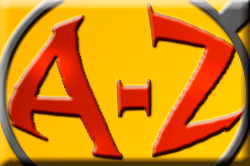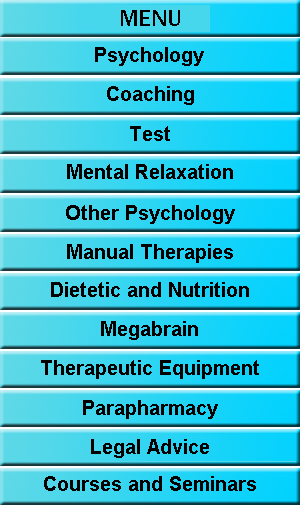

From these pages, our center provides you with a description of the symptoms of the most common diseases and disorders of the mind. Know that this relationship is purely informational and should under no circumstances be used for diagnostic, as this mission is optional, only, duly qualified professionals.
To make it easier to use, this relationship is sorted alphabetically. If you know the name of the disorder or disease that interests you, click on the letter that its name starts, in the following menu to go to the page that contains it.
| A (to Anorexia) |
Or if you prefer, directly looking for the name, you're interested in the alphabetical list of all the disorders or diseases that we see in this glossary, we offer you below:
NO INFORMATION
KOTZWARA'S SYNDROME (EROTIC ASPHYXIATION)
MUNCHHAUSSEN SYNDROME BY PROXY
NARCISSISTIC PERSONALITY DISORDER
OBSESSIONAL PHENOMENA OF NORMALITY
NO INFORMATION
|
INITIAL |
|
Name |
|
Characteristics and Symptoms |
|
It is a disorder of sensory
perception, the result is the distorted perception of
reality. The victim feels or hears something, but attributed
a different meaning corresponding to that perception. This
distortion of perceptions can be triggered by various
causes, including organic, by a very high emotional
intensity, which also produces anxiety and depressive
affect, marked by catathymic illusions, in the latter, the
evidence is variable and the patient can doubt them. |
|
Habitual Treatment |
|
The treatment is psychiatric and pharmacologic |
|
Name |
|
Characteristics and Symptoms |
|
It is a thought disorder, affecting language, like disintegration, but this is because the words that have no coherence between them. It is typical of dementia. |
|
Habitual Treatment |
|
The treatment is neurologic. |
|
Name |
|
Characteristics and Symptoms |
|
It is a thought disorder
that is characterized by the low fluidity of thought and
difficulty finding words. |
|
Habitual Treatment |
|
The treatment is psychiatric and pharmacologic |
|
Name |
|
Characteristics and Symptoms |
|
Insomnia is the inability to
sleep or sleeping discontinuously. |
|
Habitual Treatment |
|
Psychological therapy, supported with relaxation techniques and / or hypnosis, gives very good results in most cases, but depending on the associated disorder, may require medical and / or psychiatric treatment. |
|
INITIAL |
|
Name |
|
NO INFORMATION |
|
Characteristics and Symptoms |
|
|
|
Habitual Treatment |
|
|
|
INITIAL |
|
Name |
|
Characteristics and Symptoms |
|
Habitual Treatment |
|
|
|
Name |
|
Characteristics and Symptoms |
|
Habitual Treatment |
|
|
|
INITIAL |
|
Name |
|
Characteristics and Symptoms |
|
It is a form of aphasia, caused by brain injuries, in which a debit decrease is experienced, (number of words per minute). Typically occurs in motor aphasia. |
|
Habitual Treatment |
|
The treatment is neurologic. |
|
Name |
|
Characteristics and Symptoms |
|
It is a language rhythm
disorder that causes a way of talking about overly generous
description of images and concepts. |
|
Habitual Treatment |
|
The treatment is psychiatric and pharmacologic. |
|
INITIAL |
|
Name |
|
Characteristics and Symptoms |
|
This disorder is considered
to be diametrically opposed to depression. It is
characterized by euphoria and exaggerated joy, for great
optimism (jokes and jokes constantly), the speed of thought
is very fast, tachypsychia, there is a torrential language,
verbiage, where the patient does not have time to pronounce
everything thinking, this is known as pseudo disintegrated
thinking, flight of ideas. Tend to overestimate their
capabilities and minimize inconvenience, which in many cases
makes big mistakes, which can easily lead you to ruin.
Psychomotor is also exalted with increased hunger and sex
drive and reduces the need for sleep. Risk of suicide. |
|
Habitual Treatment |
|
The treatment is psychiatric and pharmacologic. |
|
Name |
|
Characteristics and Symptoms |
|
The manic depressive psychosis, also known as affective
psychosis, is a mental illness that is characterized by two
distinct phases implied: |
|
Habitual Treatment |
|
The treatment is psychiatric. |
|
Name |
|
Characteristics and Symptoms |
|
In this disorder, the affected simulates or causes diseases to be treated medically and undergo surgery. This condition is usually a way to demand attention and as a search for the magic that entails for them all the medical technology. |
|
Habitual Treatment |
|
The treatment is psychiatric. |
|
Name |
|
Characteristics and Symptoms |
|
This disorder, as the previous one is a way to demand attention, but in this case not for himself, but for someone close. The most frequent case of mothers who cause their children diseases, eg diarrhea, to be cared for medically. |
|
Habitual Treatment |
|
The treatment is psychiatric. |
|
INITIAL |
|
Name |
|
Characteristics and Symptoms |
|
It is included in personality disorders and is characterized by excessive attachment to himself. Liking oneself excessively. |
|
Habitual Treatment |
|
The treatment is psychiatric and pharmacologic. |
|
Name |
|
Characteristics and Symptoms |
|
It is a sleep disorder where who sufferer it, he falls asleep suddenly without first had a feeling that I could sleep. The dream last a short time. This short and sudden sleepiness is considered that may be due to genetic factors and often appears in adolescence or young adulthood. Have similar incidence in both sexes. Seizures usually last between 5 and 15 minutes and disappear as suddenly as they appear. They may be accompanied by cataplexy (loss of muscle tone), sleep paralysis (loss of ability to move during sleep and waking) and hallucinations. |
|
Habitual Treatment |
|
Psychiatric treatment. They respond well to stimulant medication, although there cataplexy and / or hallucinations are more resistant |
|
Name |
|
Characteristics and Symptoms |
|
It is a disorder of sexual
behavior, very rare, where the sufferer gets sexual pleasure
with dead. |
|
Habitual Treatment |
|
The treatment is psychiatric. |
|
Name |
|
Characteristics and Symptoms |
|
It is a language disorder where the affected creates new words to describe thoughts that can not explain and typically uses. |
|
Habitual Treatment |
|
Treatment can be neurologic or psychiatric. |
|
Name |
|
Characteristics and Symptoms |
|
Habitual Treatment |
|
|
|
Name |
|
Characteristics and Symptoms |
|
Habitual Treatment |
|
|
|
Name |
|
Characteristics and Symptoms |
|
This disorder usually occurs in children between 5 and 7 years and is rare after puberty. Is the sudden emergence of a strong body and vegetative agitation, accompanied by panic states. Appears sweating, rapid pulse, screams, groans, sometimes incorporated into the bed. They have feelings of oppression, paralysis, asphyxiation, and suffering intense fear. It may be difficult to awaken, but then go back to sleep and waking often not remember the episode. Not usually indicate diseases, except in cases that remain after puberty. |
|
Habitual Treatment |
|
If necessary, the treatment may be psychiatric or psychological. |
|
INITIAL |
|
Name |
|
Characteristics and Symptoms |
|
This disorder is framed
within the obsessive disorders. |
|
Habitual Treatment |
|
Although they tend to disappear on their-self, it is sometimes necessary to take a brief psychological therapy. |
|
Name |
|
Characteristics and Symptoms |
|
Have the same characteristics that obsessive neurosis but more intensity. SEE OBSESSIVE NEUROSIS |
|
Habitual Treatment |
|
|
|
Name |
|
Characteristics and Symptoms |
|
It is part of the important
obsessive disorders. There are criteria by some
professionals do not consider it as obsessive neurosis,
because they believe that in obsessive disease are
endogenous and therefore is more serious than neurosis. |
|
Habitual Treatment |
|
The treatment that is best
results are with psychological therapy with behavior
modification techniques and relaxation techniques. They also
tend to find good answers with the use of hypnosis. |
|
Name |
|
Characteristics and Symptoms |
|
It is part of the important obsessive disorders. There are
criteria by some professionals do not consider it as
obsessive disease, because they believe that in obsessive
disease are endogenous and therefore is more serious than
neurosis. |
|
Habitual Treatment |
|
The treatment that is best results are with psychological
therapy with behavior modification techniques and relaxation
techniques. They also tend to find good answers with the use
of hypnosis. |
|
Name |
|
Characteristics and Symptoms |
|
It is a way of acting, characterization of a lifestyle. It
has two forms: |
|
Habitual Treatment |
|
Works well with psychological therapy relaxation techniques or hypnosis, but can be specified psychiatric treatment. |
|
Name |
|
Characteristics and Symptoms |
|
Obsessive compulsive disorder have similar symptoms that obsessive neurosis and obsessive disorder. The intensity of this symptoms is greater than in the neurosis. |
|
Habitual Treatment |
|
Treatment is usually psychiatric, in some cases it may be sufficient to psychological therapy. In other useful combination of both. |
|
Name |
|
Characteristics and Symptoms |
|
They are in line with the exogenous disorders and are those that cause dementia states. |
|
Habitual Treatment |
|
The treatment can be, depending on the source, psychiatric and / or neurological |
|
INITIAL |
|
Name |
|
Characteristics and Symptoms |
|
In this disorder, the person feels is observed, persecuted, is due to an incorrect assessment of external stimuli which leads to delusion situations. Ranging from the classic paranoia, to disorders that come and go. Not usually affect other areas, so the person, except as noted, can lead a normal life |
|
Habitual Treatment |
|
The treatment is psychiatric and pharmacologic. |
|
Name |
|
Characteristics and Symptoms |
|
This sexual behavior disorder where the sufferer has exclusive or predominant sexual fondness for children. |
|
Habitual Treatment |
|
The treatment is psychiatric. |
|
Name |
|
Characteristics and Symptoms |
|
The paramnesias are memory distortions in pathological degree. It includes details of the meanings or false emotions or temporary space relationships wrong (déjà vu, déjà vécu and déjà entendu). Usually arise from temporal lobe epilepsy. |
|
Habitual Treatment |
|
The treatment is psychiatric and / or neurologic. |
|
Name |
|
Characteristics and Symptoms |
|
It is included in personality disorders and is characterized by feelings of being watched and persecuted, like those of paranoid disorder |
|
Habitual Treatment |
|
The treatment is psychiatric and / or neurologic. |
|
Name |
|
Characteristics and Symptoms |
|
The schizophrenia are
chronic psychotic illnesses. The sufferer, is often unaware
of their disease and lose the universal logic of things. |
|
Habitual Treatment |
|
Treatment is psychiatric and pharmacologic and in some cases electroshock. Although there is usually a deterioration of the affected to be increasing as suffering outbreaks or spends time. |
|
Name |
|
Characteristics and Symptoms |
|
It is a disorder in the content of thought where the patient does not fully explain what you want. Dwell on this theme and repeats it over and over again. |
|
Habitual Treatment |
|
The treatment is psychiatric and / or neurologic |
|
Name |
|
Characteristics and Symptoms |
|
It's repeating things over and over again as a result of brain injury. |
|
Habitual Treatment |
|
The treatment is neurologic. |
|
Name |
|
Characteristics and Symptoms |
|
Personality disorders are mood disorders, which can not properly be regarded as mental illness and are shaped from infancy to maturity, in terms of environment and genetics. Its effects may be relaxed, but hardly heal completely. |
|
Habitual Treatment |
|
The treatment is psychiatric and / or psychological. |
|
Name |
|
Characteristics and Symptoms |
|
It is a disorder of consciousness in which a person who is one of their amputated limbs (arms, legs), will continue to perceive them as existing and can even notice pain in them. This disorder disappears by itself after a certain time. |
|
Habitual Treatment |
|
Not require treatment in itself, but sometimes psychological therapy helps amputee find acceptance of the new situation. |
|
Name |
|
Characteristics and Symptoms |
|
It is an eating disorder in which the patient ingests
non-food substances such as paper, stones, etc. |
|
Habitual Treatment |
|
The treatment is psychiatric. |
|
Name |
|
Characteristics and Symptoms |
|
This male disorder, is
characterized by the occurrence of orgasm too quickly and is
a source of frustration in the relationship. |
|
Habitual Treatment |
|
The treatment is psychological. |
|
Name |
|
Characteristics and Symptoms |
|
It is a disease within the group of agnosia in which the person can not recognize faces. Recognizes partners for voice or clothing. It is a consequence of lesions in the right hemisphere. |
|
Habitual Treatment |
|
The treatment is neurologic. |
|
Name |
|
Characteristics and Symptoms |
|
It is a disorder of thought content where the ability to synthesize lost. There is an unnecessary detail, that distracts the subject really important. |
|
Habitual Treatment |
|
The treatment is psychiatric. |
|
Name |
|
Characteristics and Symptoms |
|
It is a disorder of attention in which there is apparently a lack of attention, but it really fails is performance. It is fairly typical in obsessive as it seems they do not pay attention, but what really happens is that the focus on their obsession, have no time for other things. In addition to the obsessive, it may be associated with other diseases. |
|
Habitual Treatment |
|
The treatment is psychiatric. |
|
Name |
|
Characteristics and Symptoms |
|
In pseudo-hallucinations lack any of the three rules of
hallucinations. The most common is that the perception of
voices is not external, but internal. |
|
Habitual Treatment |
|
The treatment is psychiatric. |
|
INITIAL |
|
Name |
|
NO INFORMATION |
|
Characteristics and Symptoms |
|
|
|
Habitual Treatment |
|
|

Consulting of Psychology and Health Montse Valls Giner
Powered by Monvall.com